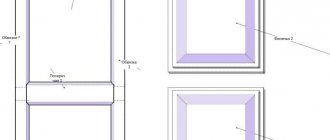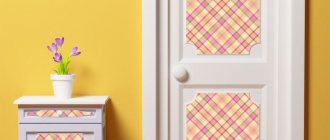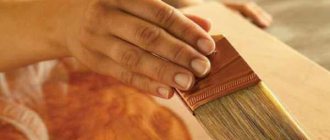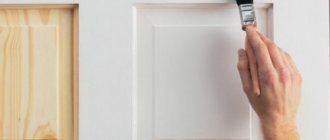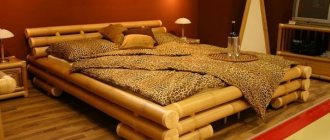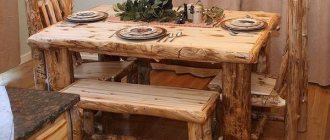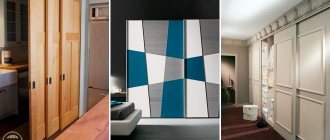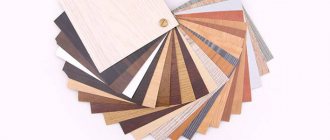A door made of natural wood will always be in fashion. She is always 100% unique. After all, the natural pattern of wood cannot be repeated twice. This door is durable and strong. Such products can last for centuries. In addition, doors made of natural wood amaze with their charm and charm. And the aroma that will emanate from it cannot be replaced by any door made of plastic or MDF. Making such a product at home is easy, if you have the tools and good materials. Go.
What type of wood to choose
Everyone knows from school that there are deciduous and coniferous trees. Each breed has its own pros and cons. Before you start making a door, you need to understand the nuances and properties of each type. Why is it important? Not only the appearance of the door, but also its durability depends on the choice of material.
All types of wood differ in density and hardness. Soft rock is easy to work with, but it quickly absorbs moisture from the air. This means that at different times of the year it will change its dimensions. Hard rock, on the contrary, is resistant to high humidity. But in work, during manufacturing, you will have to put in more effort. Soft - suitable for doors in the house. Solid - for street doors.
When choosing a material, you should also take into account the amount of resin. In other words, you want the most “resinous” rock. And here larch is in the lead. A door made of this type is resistant to rain and air humidity. The composition of the resin protects it from swelling and deformation in general.
Larch texture
If you need a “not front” door and appearance plays the last role in it, then old boards will do.
But if appearance is important, then it is better to order new material, based on the following criteria:
- Board without knots. Or with a minimum quantity.
- Wood humidity up to 15%.
- Perfectly even and smooth.
Larch timber for making doors
Rules and regulations for the production of interior doors
Door blocks are manufactured using equipment located in large production areas. These premises have certain requirements, as do industrial facilities, which include timber warehouses, dryers, a processing shop, a paint and varnish department and a finished product warehouse. Each production site is set up according to the rules and regulations, in accordance with the technical conditions for a specific task. The main requirements for industrial premises for the production of doors are the following criteria:
- availability of free access roads;
- buildings must ensure stable temperature, humidity, natural and artificial lighting;
- electricity supply, heating, ventilation, water supply and sewerage must be provided;
- premises must be equipped with fire alarms, fire extinguishing equipment and emergency exits;
- it is necessary to ensure safe working conditions in the workplace;
- paint areas must be isolated from other rooms and provided with fresh ventilation.
Personnel are required to undergo professional training and education in labor protection, fire and electrical safety standards, as well as undergo unscheduled, repeated and initial briefings in the workplace.
The production facility must be equipped in accordance with standards
The main standard for the production process is technological documentation, which is based on Technical conditions for production TU 5361−001−58037723−2015 “INTERIOR DOORS, PARTITIONS AND MODELED PRODUCTS FOR THEM.” This document sets out the requirements for the design of interior doors, the quality of material and coating of the front surface, as well as environmental requirements. The standards specify the procedure for acceptance of finished products, certification and installation of a warranty period.
It is important for the buyer to have a certificate, a warranty period and compliance of the door, frame and additional elements with the requirements of technical specifications, since this confirms the quality of the product and allows one to count on a long service life.
Hardwood
- Oak. Noble and beautiful. It is a hard rock, but is prone to splitting.
- Beech. Moisture and dampness are its main enemies. But despite this it has high strength.
- Birch. It has a beautiful natural pattern and is pleasant to touch. It is a hard rock, which means it will be difficult to work with.
- Maple. Medium hardness, works well. Moisture resistance is average.
- Nut. The sinuous natural pattern of the tree attracts the eye. Moisture resistant and easy to work with.
- Alder. Belongs to soft breeds. Suitable for home doors where there is no moisture and is always dry.
For street doors, beech and oak are most often chosen.
Beam made of oak (left) and beech (right)
Advertising Tools
Considering the high competition in the interior door market, it is extremely difficult to achieve business success without a high-quality advertising campaign. Among the most effective advertising tools are the following:
- A website with detailed information about the types and options of doors, their photos and descriptions, answers to frequently asked questions, etc. It is imperative to indicate the contacts of the company and take care of prompt feedback.
- Online store;
- Groups on social networks. It is convenient for clients to learn company news without interrupting their daily communication.
- Video channel on YouTube. Here you can post reviews of new models, production processes, installation, and useful information.
- Contextual advertising. Unfortunately, without it, Internet promotion does not bring tangible results.
- Advertising printing (posters, booklets, catalogues, calendars). Sales representatives will work with these products.
- Software designers for selecting doors to the interior and modeling product configurations. It’s logical to post them on the company’s website.
Coniferous wood
- Pine. The most popular type of conifer. It is soft and a pleasure to work with. But as we remember, soft rocks do not tolerate moisture well and begin to rot. This breed is almost always used for making home doors.
- Larch. The beautiful texture and high resin content make this wood an ideal material for entrance doors.
- Spruce. Similar in properties to pine. Only spruce is even softer and less durable.
Material for work
A popular and inexpensive material suitable for making doors is lumber from pine trees. The use of spruce is undesirable, since the structure of the tree is quite unstable and during processing a large number of knots and chips are formed.
Making beautiful and smooth doors from pine wood involves, first of all, the correct choice and technology for preparing the boards. It is necessary to choose lumber with an even structure, without obvious chips or flaws. You also need to pay attention to the color of the boards. The presence of some blue on the surface of the boards is direct evidence of gross violations in storage technology. The use of such boards is highly undesirable, since rotting processes will soon begin in them.
What is needed for making
Once you have decided on the type of wood to choose, it’s time to move on to the practical part. You need to understand that having only a screwdriver with you will not work. In production conditions there is a whole system of expensive machines. Which, along the chain, perform each operation separately.
Of course, no one will install such equipment at home. You will need a minimum set:
- Electric saw with disc
- Small hand router
- For the final decoration of the door, it is advisable to acquire a spray gun.
- For the door itself, a dry board without knots with a thickness of 50 mm (for a street door) or 25 mm (for a home door).
- Accessories for a complete set: lock, handle, hinges, peephole.
After purchasing wooden boards, the first thing to do is let them dry. Lay them out in a row on a flat surface.
Estimated business plan
Renting premises
For the production of interior doors made of natural wood (oak, pine) with veneer of various types of wood, the company (LLC on the general taxation system) rented a production facility with an area of 450 m2.
Plans for production volumes
Planned production output: 800 l.m/year
Ways of implementation:
- through our own warehouse store;
- through a network of construction supermarkets;
- on a contractual basis with construction contractors.
Capital expenditures
Equipment for the production of solid wood doors:
- drying chamber – 35 thousand rubles;
- band sawmill – 110 thousand rubles (Fig. 15);
- tenon cutting machine for trimming lamellas and cutting tenon joints – 170 thousand rubles;
- cross-cutting press – 220 thousand rubles (Fig. 16);
- pneumatic press for forming a shield – 180 thousand rubles (Fig. 17);
- format-cutting machine for sawing lumber – 200 thousand rubles;
- milling and copying machine – 90 thousand rubles (Fig. 18);
- grinding machine – 100 thousand rubles (Fig. 19);
- auxiliary equipment (construction tools) – 50 thousand rubles.
Total: 1,155,000 rub.
Rice. 15
Rice. 16
Rice. 17
Rice. 18
Rice. 19
Material costs for raw materials
Material costs to start production:
- sawn oak – 50 m3 * 6,500 rubles = 325,000 rubles;
- glue – 500 kg * 110 rubles = 55,000 rubles;
- fittings (handles, hinges, latches) – RUB 30,000.
Total: 410,000 rub.
Salary
To ensure production activities, it is planned to hire the following staff:
- director,
- accountant,
- sales manager,
- 5 workers to service machines and assemble doors.
Payroll – 120 thousand rubles/month.
Payroll taxes (37.5%) – 45,000 rubles/month.
Calculation of the actual cost of production
Fixed costs (rub/year):
- salary – 1,440,000;
- taxes – 540,000;
- rent – 500,000;
- utilities - 60,000;
- advertising – 120,000;
- depreciation of fixed assets – 52,750
- reserve fund – 54,255.
Total: RUB 2,767,005/year.
Material costs per 1 m.p. products:
- edged board – 1/8 m3 * 6500 rubles = 812.5 rubles;
- glue - 0.4 kg/m3 * 110 rub/kg = 44 rub;
- frosted decorative glass – 0.3 m2 * 1300 rubles = 390 rubles;
- accessories (handles, hinges, screws, screws) – 300 rubles;
- natural oak veneer 8 m2 * 64 RUR = 512 RUR;
- paint and varnish products 0.75l * 180 rubles = 135 rubles.
Total: RUB 2193.50
Product cost for 1 year of operation = (Fixed costs: Planned annual production) + Material costs for production
RUB 2,767,005/year: 800 m.p. + (RUB 2,193.5 * 800 m.p.) = RUB 1,758,258.76
Selling price, profit
At a cost of 1 m.p. doors at 2197.82, we calculate the selling price as follows: 2197.82 + (2197.82 * 25%) = 2747.28 rubles. Of course, the selling price is set taking into account market value and competition - this is the minimum level below which the enterprise should not fall so as not to suffer losses. Annual revenue: RUB 2,747.28 * 800 m.p. = 2,197,820 rub.
Profit: 2,197,820 - 1,758,258.76 = 439,561.24 rubles/year.
Let's start production
The first thing you will need is the dimensions of the door leaf. It's simple, take a tape measure and measure the opening. Take the width and height according to the minimum size. And remember that the door frame is first installed in the opening. And the door itself is already mounted on it. Therefore, take another 5 mm on each side. So that the door fits into the frame freely.
Measuring scheme
Here is a brief diagram of how the door is made:
- Cutting boards to the required length
- Connected using wood glue
- Surface grinding
- Installation of cross bars
- Finishing chemical treatment
Organizational form and sales channels
The legal form for a business should be chosen after first assessing the potential buyer.
Here are the options:
- large wholesale - construction companies and state-owned enterprises (usually, there is a tender basis, which is quite difficult for a new player in the market to win);
- concluding agreements with networks of construction markets and specialized stores;
- sales through own retail outlets;
- dealer network.
In practice, an enterprise engaged in the production of interior doors is rarely limited to one sales option - to increase sales, all available “channels” should be developed.
Therefore, the optimal organizational form would be a legal entity - LLC (many construction companies and supermarkets simply do not cooperate with individual entrepreneurs).
The following codes must be indicated in the types of activities:
- 20.30.1 Production of wooden building structures and joinery;
- 51.53.24 Wholesale trade of other construction materials.
A license for the production of interior doors is not required. But if you plan to provide installation as an additional service, please note that without special permission, installation of door panels is only allowed in place of existing openings. If the project involves expansion or any other change in the opening, then an appropriate construction license is required.
Dowel assembly
The simplest door option. Suitable for utility rooms or baths and saunas.
- Cut the boards to the required length
- Lay out the leaf of the future door on a flat surface
- Fix the position of the blade
- Make dowels (crossbars that will hold the entire frame of the door leaf together)
- Using a router, make recesses for the keys
- Install the keys into the grooves and secure them with self-tapping screws
- Next is final sanding of the door leaf, treatment with antiseptic and paint.
Door assembled with dowels
Insulation
In most cases, the production of wooden doors also involves insulating them and ensuring sound-absorbing properties. To achieve this effect, it is possible to use external upholstery of the product. This is done by gluing the fiberboard canvas with a layer of foam rubber, retreating 10 mm from each edge. Subsequently, decorative external material will be nailed onto these free strips. However, this option is more suitable for entrance doors.
The easiest way to insulate interior fabric is by filling the voids under the fiberboard sheet with a layer of cotton wool or foam rubber.
Frame
Such doors have only a wooden frame. And inside it is filled with sawdust, shavings, chips or cardboard. Fiberboard panels are attached to the frame itself on top. How to do it:
- Prepare the board elements for the frame and two sheets of fiberboard of the required size.
- Fasten the frame with self-tapping screws and lay the first sheet of fiberboard on top. Attach it with nails or pins.
- You turn the entire structure over and fill the voids of the frame.
- Lay the second sheet and attach it to the frame.
- Final decorative finishing
Frame door in the process of assembly
Latest Market Trends
If we talk about the latest trends in the door industry, then the most obvious factor here will be consolidation on one specific type of product, for the production of which the maximum amount of both financial, production and human resources is allocated. Nowadays, most manufacturers do not try to cover the largest possible number of models, while simultaneously producing doors in artificial coverings, solid wood and natural veneer. Now everyone tries to become the most professional in one specific area, without scattering their efforts. It is much easier (and most likely more correct) for companies to make a quality offer in one specific segment.
New trends also include the decline in the popularity of models coated with veneer and especially Fine-line veneer; it was replaced by artificial films and painted doors with enamel coating, which can be called the fastest growing segment. The external characteristics of such models differ for the better, and the richness of colors allows you to choose the necessary solution.
Panel assembly
The most complex and beautiful version of doors. This door consists of a frame made of solid wood and internal inserts with a milled pattern (panels) and geometry made of the same wood. The whole structure comes together like a puzzle. As a result, you get a beautiful and durable product.
- For the frame, the vertical components of the frame are first made. And then the jumpers. Top, middle and bottom.
- Process the vertical posts with a router along the edges. And also make a groove for inserting crossbars and panels.
- The counter strips are milled on the horizontal strips. They should fit into the grooves of the verticals.
- Make panels. Leave the groove at the edges 2 mm thicker than the groove in the verticals.
- Assemble the entire structure using wood glue.
- This is precision jewelry work. Be careful when calculating sizes.
Door with panels
Certification, quality standards
According to current legislation, among the types of products that a manufacturer of interior doors could hypothetically produce, only wooden balcony blocks are subject to mandatory certification. This position will require a declaration of quality conformity.
For goods not included in the “List of Products Subject to Mandatory Certification” and “List of Products Subject to Mandatory Declaration” (RF Government Decree 01.12.2009), it is recommended to obtain a voluntary certificate from an accredited certification center. The presence of this document will help increase the company’s competitiveness and increase loyalty to products among consumers.
To issue a voluntary certificate of conformity, you will need to provide the company's Charter, INN, OGRN, as well as technical documentation for manufactured products (TU, GOST), documents certifying ownership of the premises (or lease agreement), as well as details of the recipient of the certificate. The composition of the required package of documents must be clarified at the certification center.
To pass all inspections, products must meet the following standards:
- GOST 475-78 – “Wooden doors. General technical conditions (with Amendments No. 1, 2)";
- GOST 6629-88 – “Internal wooden doors for residential and public buildings. Types and design";
- GOST 26602.2-99 – “Window and door blocks. Methods for determining air and water permeability";
- GOST 26602.1-99 – “Window and door blocks. Methods for determining heat transfer resistance”;
- ST SEV 3285-81 – “Wooden doors. Reliability testing methods";
- GOST 28786-90 – “Wooden doors. Method for determining resistance to climatic factors";
- GOST 24698-81 – “Wooden external doors for residential and public buildings”;
- GOST 8904-2014 – “Solid wood fiber boards with paint and varnish coating. Technical conditions";
- GOST 2977-82 – “Sliced veneer. Technical specifications (with Amendments No. 1, 2, 3)";
- GOST 29027-91 – “Moisture meters for solid and bulk substances. General technical requirements and test methods".
How to make a wooden door with your own hands - step by step guide
The market offers a wide range of different doors. But sometimes it is difficult to choose a model that fully meets the owner’s needs. There are plenty of reasons - a significant difference in dimensions (block/opening), low quality products, poor external design, high cost, and so on. For a person who is familiar with household tools, making interior doors with your own hands is not a problem. In many cases, this solution is the most rational.
